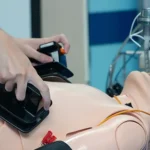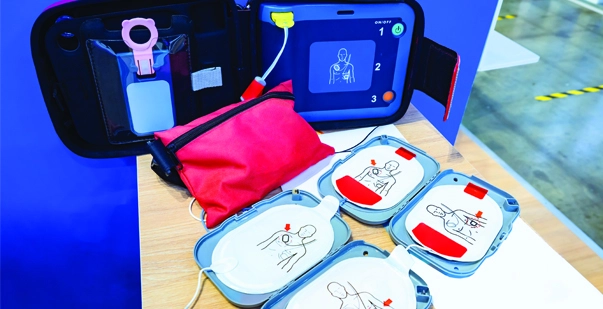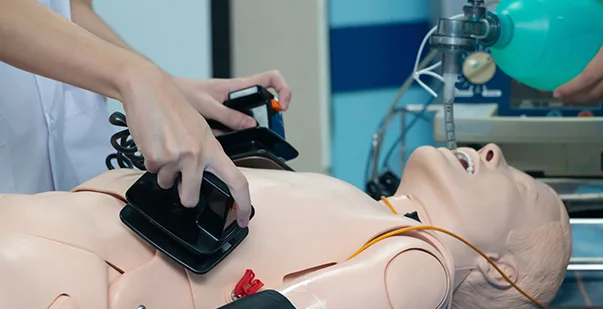In the critical moments following a sudden cardiac arrest (SCA), an automated external defibrillator (AED) can be a lifesaving device. In the United States, someone experiences a sudden cardiac arrest every 90 seconds. This is alarming and necessitates the need for AEDs in our lives. This blog will explore more about AED usage and shed light on the scenarios of when to use AED and when not to use an AED. Keep reading to explore more:
When to use a defibrillator?
Automated external defibrillators (AEDs) are crucial tools that are portable devices and easy to use. By playing an important role during life-saving emergencies, the AEDs can make the necessary difference between life and death. Know why is an AED needed:
- Cardiac Arrest: Heart attack defibrillation is beneficial, where the rhythm of the heart becomes chaotic, making it life-threatening. AEDs study the heart’s electrical activity and deliver a shock when needed to normalize its work.
- Unconsciousness with Absence of Pulse: In situations where a person is unresponsive, an AED may evaluate the underlying cardiac rhythm within the patient medically as well as technically.
- Breathing Difficulty with Unresponsiveness: An AED can help if a person stops breathing and becomes unresponsive. It not only analyzes the heart rhythm but also provides CPR instructions, prompts, and encourages effective resuscitation attempts.
- Suspected Heart Attack: Although AEDs are mainly intended for use during sudden cardiac arrest, a heart attack causes an alarming condition of arrested sigh and circulation following it.
- Drowning Incidents: AEDs are very useful in scenarios where drowning has caused cardiac arrest. Immediate AED usage can help revive a victim and strengthen other lifesaving procedures.
- Severe Electric Shock: In cases of a severe electrical shock leading to cardiac arrest, AEDs can be used only after making sure the victim is safe from any potential electric hazards, which could become part of an effective emergency response plan.
Read More: How to Look for AED/CPR Classes Near Me?
When should you not use an AED?
While automated external defibrillators (AEDs) are crucial tools during cardiac emergencies, there are a few scenarios where their use is not appropriate. Understanding when not to use an AED helps prevent potential harm while ensuring the safety of both responders and the victim. Here are instances when you must not use an AED:
- Non-Cardiac Arrest Situations: AEDs can treat sudden cardiac arrest where the heartbeats become irregular and jeopardize life. If a person is conscious, breathing, and has a pulse, he or she isn’t suffering from cardiac arrest, so there would be no reason to use an AED.
- Wet or Waterlogged Environments: Water and electricity do not go well together. In wet or waterlogged conditions, using an AED carries the risk of electrical shock to both the victim and the rescuer. First, take the victim to a place that is dry, and then proceed with the AED application; this will protect everyone involved.
- Presence of Flammable Substances: AEDs produce electrical current, so in areas where gases or substances are flammable, there is a danger of ignition. This is because using an AED in such areas may cause a fire to start. Hence, ensure the scene is free from flammable materials before contemplating AED application.
- Traumatic Cardiac Arrest: Cardiac arrest is associated with trauma, including severe injuries from accidents or falls. In such instances, the main concern should be to deal with trauma injuries. AEDs are not intended to treat trauma, so concentrate on immediate medical care and follow the right path for the treatment of traumatic conditions.
- Do-Not-Resuscitate (DNR) Orders: If the victim has a Do-Not-Resuscitate (DNR) order, it is legally and ethically mandatory to respect their wishes. The AED application in this type of case contradicts the documented preferences of an individual regarding end-of-life care.
- Childbirth: You should not use AEDs during childbirth. If a woman in labor goes into shock, the first thing should be to secure emergency medical service and perform basic life support until professional help arrives at the scene of the collapse. Childbearing is a great medical occurrence, and AEDs are not prepared to tackle its peculiarities.
Additional warnings for AED users
In certain cases, you will need extra precautions, especially while handling cardiac arrest sufferers. Here are certain warnings that must influence you on ways to administer treatment:
- The victim has wet hair or lies in water: Water and electricity don’t mix. In the case of a cardiac victim drowned by water or lying in it, move him away from this liquid and dry his chest totally before you try shocking. Or if there are any sort of combustible materials nearby, such as solvents or fuel, move away from the source of these before using this device.
- The victim wears a medication patch or pacemaker: Packers are easily noticeable. It is about half the size of a deck of cards and will make a hard lump in the victim’s chest. Do not place the AED pad directly over a pacemaker. Put it directly towards the target area without touching the pacemaker. Take off this medication patch from the chest of the patient and clean it with a quick swipe before putting it on the pad. Do not try to install the pad on top of the patch.
- The victim has hair on their chest: Excessive body hair can disrupt the AED’s capacity to recognize a shockable rhythm. If a razor is accessible, attempt to shave the target region prior to applying pads. In case no razor is near, apply as much direct pressure to the pads to ensure conduction. Make sure you do not touch the victim’s bare skin when sending shocks.
Read More: Rescue Breathing vs CPR: The Basic Difference
Conclusion
While it can be difficult to decide when to use an AED and when not to, recap it as simply as possible, it all rests on three basic questions:
- Is it a cardiac arrest?
- Is the AED operable?
- Is it safe to deliver electric shocks to the victim?
If you can answer yes to all the questions, it is time to grab the defibrillator. If the answer to any of the above questions is no, consider other options. You never know when a cardiac emergency will strike; ensure to keep an AED machine handy.










